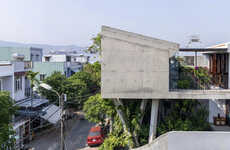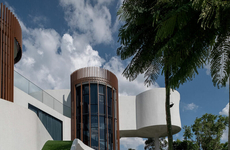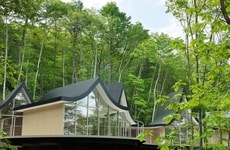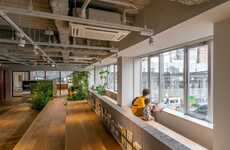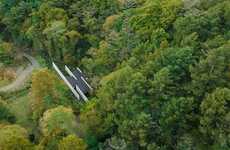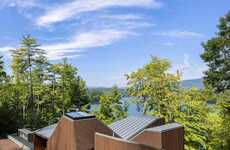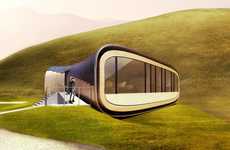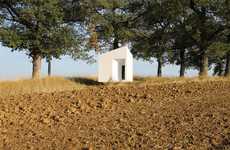
Nest by UID Architects is Open to the Forest Beneath It
Amelia Roblin — May 15, 2011 — Art & Design
References: maeda-inc.jp & dezeen
Early architecture satisfied the need for shelter and not necessarily for complete enclosure. Nest by UID Architects is an example of a contemporary structure that broke down the conventions of closed-off construction, creating a negligible threshold between outside and inside.
The family home is located in Onomichi-city of Hiroshima, Japan, amid the gorgeous overgrowth of a forest. The base of the building is on solid footing, of which the gray concrete structure incorporates rigid pathways lined with lush gardens of rocks, moss, plants and even trees. The second floor of the structure is just as marvelous as the one below. Built of plywood paneling, it has gaping rectangular windows and skylights that the sun and leafy branches use to infiltrate the interior spaces of Nest by UID Architects.
The family home is located in Onomichi-city of Hiroshima, Japan, amid the gorgeous overgrowth of a forest. The base of the building is on solid footing, of which the gray concrete structure incorporates rigid pathways lined with lush gardens of rocks, moss, plants and even trees. The second floor of the structure is just as marvelous as the one below. Built of plywood paneling, it has gaping rectangular windows and skylights that the sun and leafy branches use to infiltrate the interior spaces of Nest by UID Architects.
Trend Themes
1. Open-concept Architecture - The trend of creating structures with negligible threshold between outside and inside creates opportunities for innovative building designs that prioritize connection to nature and the environment.
2. Integration of Natural Elements - Incorporating rocks, moss, plants and trees into architectural design creates unique and visually compelling structures that serve a functional purpose in addition to aesthetics.
3. Green Building - Building structures that harmonize with the natural environment as well as utilize sustainable materials and energy sources further popularizes environmentally-friendly architecture.
Industry Implications
1. Architecture - Architects and engineers can leverage these trends to create unique and sustainable designs that challenge traditional construction conventions.
2. Real Estate - Developers and real estate agents can market properties that offer open-concept architecture and natural elements as desirable and unique features that elevate a property's value.
3. Furniture and Decor - As people begin to prioritize connection with nature and the environment in their living spaces, there is an opportunity for furniture and decor companies to create designs that harmonize with open-concept architecture and natural elements.
6.4
Score
Popularity
Activity
Freshness

